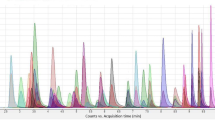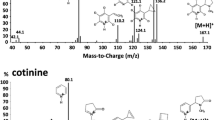Abstract
This study reports the development and validation of a method using hydrophilic interaction liquid chromatography–tandem mass spectrometry (HILIC-MS/MS) for the analysis of cocaine and its metabolites benzoylecgonine (BE), ecgonine methyl ester (EME), and cocaethylene (CE) in hair samples. Decontamination was performed as follows: Firstly, the aliquot of hair was briefly rinsed with 2 mL dichloromethane, then was washed three times with 10 mL 0.01 M phosphate buffer, pH 6, for 15 min, followed by 2 mL 2-propanol for less than 2 min, and, finally, a last rinse with 2 mL dichloromethane was again done. Cocaine compounds were extracted from 10 mg of hair by incubation with 2 mL 0.1 M HCl at 50 °C for 12 h and purified by solid phase extraction with Oasis MCX cartridges. Analysis was performed by LC-MS/MS using an Atlantis HILIC silica chromatographic column. The method was fully validated. Linearity was established over the concentration range 0.020–10.0 ng/mg for cocaine (COC), 0.010–10.0 ng/mg for BE and CE, and 0.005–2.0 ng/mg for EME, and the correlation coefficients were all >0.99. Extraction efficiency was >70% for all analytes. Limits of detection were 0.0005 ng/mg for CE and 0.001 ng/mg for the other analytes (COC, BE, and EME). Lower limits of quantification were the lowest points of the calibration curves with acceptable accuracy and precision (coefficient of variation ≤20%). Intra- and inter-day imprecision ranged between 1.5% and 9.5% and 0.7% and 12.6%, respectively. Intra- and inter-day inaccuracy ranged from 0.5% to 12.3% and from 0.7% to 7.1%, respectively. With regard to matrix effects, suppression was <27.5% in all cases. The method was applied to the analysis of several samples derived from forensic cases.


Similar content being viewed by others
References
European Monitoring Centre for Drugs and Drug Addiction (EMCDDA) (2009) Annual report 2009: the state of the drugs problem in Europe. Luxembourg: Publications Office of the European Union, 99 pp. http://www.emcdda.europa.eu/publications/annual-report/2009. Accessed 20 Nov 2009
Jurado C (2007) Análisis de drogas de abuso en muestras de pelo. Diagnóstico del consumo crónico. Trastornos Adictivos 9(3):172–183
Barroso M, Dias M, Vieira DN, Queiroz JA, López-Rivadulla M (2008) Simultaneous determination of cocaine and its main metabolite, benzoylecgonine, in human hair by gas chromatography/mass spectrometry. Rapid Commun Mass Spectrom 22(20):3320–3326
Cristoni S, Basso E, Gerthoux P, Mocarelli P, Gonella E, Brambilla M, Crotti S, Bernardi LR (2007) Surface-activated chemical ionization ion trap mass spectrometry for the analysis of cocaine and benzoylecgonine in hair after extraction and sample dilution. Rapid Commun Mass Spectrom 21(14):2515–2523
Vogliardi S, Favretto D, Frison G, Ferrara SD, Seraglia R, Traldi P (2009) A fast screening MALDI method for the detection of cocaine and its metabolites in hair. J Mass Spectrom 44(1):18–24
Lachenmeier K, Musshoff F, Madea B (2006) Determination of opiates and cocaine in hair using automated enzyme immunoassay screening methodologies followed by gas chromatographic–mass spectrometric (GC-MS) confirmation. Forensic Sci Int 159(2–3):189–199
de Toledo FC, Yonamine M, de Moraes Moreau RL, Silva OA (2003) Determination of cocaine, benzoylecgonine and cocaethylene in human hair by solid-phase microextraction and gas chromatography–mass spectrometry. J Chromatogr B Analyt Technol Biomed Life Sci 798(2):361–365
Scheidweiler KB, Huestis MA (2005) Simultaneous quantification of opiates, cocaine, and metabolites in hair by LC-APCI-MS/MS. Anal Chem 76(15):4358–4363
Miller EI, Wylie FM, Oliver JS (2008) Simultaneous detection and quantification of amphetamines, diazepam and its metabolites, cocaine and its metabolites, and opiates in hair by LC-ESI-MS-MS using a single extraction method. J Anal Toxicol 32(7):457–469
Cognard E, Rudaz S, Bouchonnet S, Staub C (2005) Analysis of cocaine and three of its metabolites in hair by gas chromatography–mass spectrometry using ion-trap detection for CI/MS/MS. J Chromatogr B Analyt Technol Biomed Life Sci 826(1–2):17–25
Bourland JA, Hayes EF, Kelly RC, Sweeney SA, Hatab MM (2000) Quantitation of cocaine, benzoylecgonine, cocaethylene, methylecgonine, and norcocaine in human hair by positive ion chemical ionization (PICI) gas chromatography–tandem mass spectrometry. J Anal Toxicol 24(7):489–495
Hoelzle C, Scheufler F, Uhl M, Sachs H, Thieme D (2008) Application of discriminant analysis to differentiate between incorporation of cocaine and its congeners into hair and contamination. Forensic Sci Int 176(1):13–18
Gheorghe A, van Nuijs A, Pecceu B, Bervoets L, Jorens PG, Blust R, Neels H, Covaci A (2008) Analysis of cocaine and its principal metabolites in waste and surface water using solid-phase extraction and liquid chromatography–ion trap tandem mass spectrometry. Anal Bioanal Chem 391(4):1309–1319
van Nuijs AL, Tarcomnicu I, Bervoets L, Blust R, Jorens PG, Neels H, Covaci A (2009) Analysis of drugs of abuse in wastewater by hydrophilic interaction liquid chromatography–tandem mass spectrometry. Anal Bioanal Chem 395(3):819–828
Giroud C, Michaud K, Sporkert F, Eap C, Augsburger M, Cardinal P, Mangin P (2004) A fatal overdose of cocaine associated with coingestion of marijuana, buprenorphine, and fluoxetine. Body fluid and tissue distribution of cocaine and its metabolites determined by hydrophilic interaction chromatography–mass spectrometry (HILIC-MS). J Anal Toxicol 28(6):464–474
Society of Hair Testing (2004) Recommendations for hair testing in forensic cases. Forensic Sci Int 154:83–84
Quintela O, Crouch DJ, Andrenyak DM (2006) Recovery of drugs of abuse from the Immunalysis Quantisal oral fluid collection device. J Anal Toxicol 30(8):614–616
Anon (1997) Society of Hair Testing. Statement of the Society of Hair Testing concerning the examination of drugs in human hair. Forensic Sci Int 84:3
Cirimele V, Kintz P, Mangin P (1996) Comparison of different extraction procedures for drugs in hair of drug addicts. Biomed Chromatogr 10(4):179–182
Clauwaert KM, Van Bocxlaer JF, Lambert WE, Van den Eeckhout EG, Lemière F, Esmans EL, De Leenheer AP (1998) Narrow-bore HPLC in combination with fluorescence and electrospray mass spectrometric detection for the analysis of cocaine and metabolites in human hair. Anal Chem 70(11):2336–2344
Dams R, Murphy CM, Lambert WE, Huestis MA (2003) Urine drug testing for opioids, cocaine, and metabolites by direct injection liquid chromatography/tandem mass spectrometry. Rapid Commun Mass Spectrom 17(14):1665–1670
Concheiro M, de Castro A, Quintela O, Cruz A, López-Rivadulla M (2007) Determination of illicit drugs and their metabolites in human urine by liquid chromatography tandem mass spectrometry including relative ion intensity criterion. J Anal Toxicol 31(9):573–580
Johansen SS, Bhatia HM (2007) Quantitative analysis of cocaine and its metabolites in whole blood and urine by high-performance coupled with tandem mass spectrometry. J Chromatogr B Analyt Technol Biomed Life Sci 852(1–2):338–344
Buck K, Voehringer P, Ferger B (2009) Rapid analysis of GABA and glutamate in microdialysis samples using high performance liquid chromatography and tandem mass spectrometry. J Neurosci Methods 182:78–84
Hemström P, Irgum K (2006) Hydrophilic interaction chromatography. J Sep Sci 29(12):1784–1821
Naidong W (2003) Bioanalytical liquid chromatography tandem mass spectrometry methods on underivatized silica columns with aqueous/organic mobile phases. J Chromatogr B Analyt Technol Biomed Life Sci 796(2):209–224
US Department of Health and Human Services, Food and Drug Administration, Center for Biologics Evaluation and Research (2001) Guidance for industry: Bioanalytical method validation, Rockville, MD, 2001. http://www.fda.gov/downloads/Drugs/GuidanceComplianceRegulatoryInformation/Guidances/UCM070107.pdf. Accessed 20 Nov 2009
International Conference on Harmonisation Tripartite Guideline (2005) ICH Topic Q2, Validation of analytical procedures: text and methodology, Geneva, 2005. http://www.ich.org/cache/compo/276-254-1.html. Accessed 20 Nov 2009
Shah VP, Midha KK, Findlay JWA, Hill HM, Hulse JD, McGilveray IJ, McKay G, Millar KJ, Patnaik RN, Powell ML, Tonelli A, Viswanathan CT, Yacobi (2000) A bioanalytical method validation–a revisit with a decade of progress. Pharm Res 17:1551–1557
Peters FT, Maurer HH (2002) Bioanalytical method validation and its implication for forensic and clinical toxicology—a review. Accred Qual Assur 7:441–449
Matuszewski BK, Constanzer ML, Chavez-Eng CM (2003) Strategies for the assessment of matrix effect in quantitative bioanalytical methods based on HPLC-MS/MS. Anal Chem 75(13):3019–3030
Jurado C, Giménez MP, Menéndez M, Repetto M (1995) Simultaneous quantification of opiates, cocaine and cannabinoids in hair. Forensic Sci Int 70:165–174
Acknowledgments
We gratefully acknowledge the support of the INCITE (Consellería de Innovación e Industria, Xunta de Galicia) by the Investigation Proyect INCITE08PXIB208090PR.
Author information
Authors and Affiliations
Corresponding author
Rights and permissions
About this article
Cite this article
Quintela, O., Lendoiro, E., Cruz, A. et al. Hydrophilic interaction liquid chromatography–tandem mass spectrometry (HILIC-MS/MS) determination of cocaine and its metabolites benzoylecgonine, ecgonine methyl ester, and cocaethylene in hair samples. Anal Bioanal Chem 396, 1703–1712 (2010). https://doi.org/10.1007/s00216-009-3393-5
Received:
Revised:
Accepted:
Published:
Issue Date:
DOI: https://doi.org/10.1007/s00216-009-3393-5




